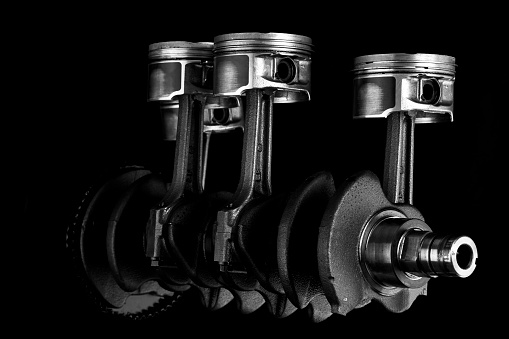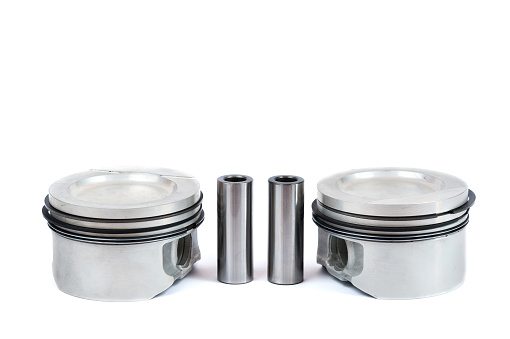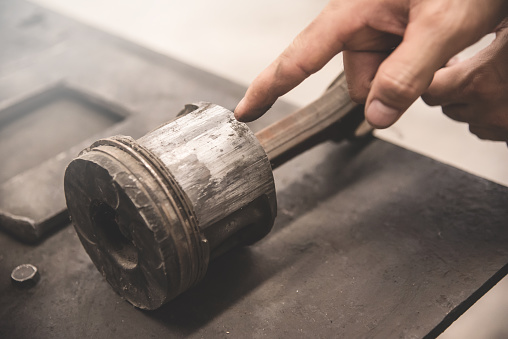SIGNS OF BAD PISTON AND PISTON RINGS IN AN ENGINE

An internal combustion engine such as a diesel engine or petroleum engine requires a good piston and piston rings for the optimum performance of the engine.
The function of the piston is to compress the air-fuel mixture in the combustion chamber and help to carry the crankshaft to revolve at its axis through the help of the power stroke coming from the combustion chamber of the engine.

The piston also helps to expel the burnt air-fuel mixture in the combustion chamber and delivers it to the exhaust channels.
The piston serves as the major part of the internal combustion engines, due to the fact that its reciprocating action in the combustion chamber is what causes the crankshaft to rotate and hence, creates the whole rotational motion of the internal combustion engines.
Mechanically, the type and size of the piston and its rings in an engine will greatly determine its overall performance including its speed and torque.
For this reason, many engine manufacturers had come up with several designs in a way to optimize the engine performance.

These designs led to the development of multiple pistons and cylinders in an internal combustion engine.
Also, it led to the development of different shapes in the internal combustion engine designs such as the V-shape design, the Y-shape design, the H-shape design, the O-shape design, etc.

These designs were used by engine manufacturers to obtain the desired performance and size needed for any purpose the engine will be meant to serve.
The majority of the internal combustion engines are now used for heavy-duty jobs and for moving industrial machines due to the increase in the size and number of pistons in the engines’ modern designs.
Some modern internal combustion engines can have about 6 to 12 pistons arranged in their various cylinder walls with their various combustion chambers.
Such engines have their piston reciprocating movement timed and controlled such that at a specific angle of the crankshaft there would be a power stroke such that the crankshaft keeps obtaining momentum from the various power strokes of the pistons.
Meanwhile, the actual function of the piston rings is to help in closing the gap in the clearance created between the piston and the cylinder wall is reciprocating inside.
Though the rings are meant to close the clearance; it is not permitted to close it completely in such a manner that would affect the reciprocating action in the cylinder wall rather they are meant to the great small allowance for lubrication on the cylinder wall.
When an internal engine is having a good piston and piston rings its performance in power output will be high as well as other factors in the engine performance.
But when the reverse is the case the following could occur and it could also serve as signs when the existing piston and piston rings have become faulty, for an engine in such condition the following could happen to the engine;
REDUCED POWER EFFICIENCY

As mentioned earlier that the power output of an internal combustion engine greatly depends on the size, type, and the number of pistons and piston rings.
If an engine was performing at an efficiency of 98% and later its efficiency drops to 80% the trace to such a drop in the power output could be attributed to the piston rings and the piston.
Research has also shown that even some new internal combustion engines due come with low efficiency in power output which can be attributed to the high allowance between the piston ring and the cylinder wall.
The major cause of the power drop could be a result of the excessive wear of the piston rings such that they now create excess allowance between the cylinder wall and the piston.
Power stroke would escape into the crankshaft zone through the excess gap between the cylinder wall and the piston rings, such that the pressure built of the mixture during the compression stroke is greatly affected.
Hence, when the power stroke takes place the power release to push the piston downward would not be the same, thereby affecting the overall engine performance.
OVERHEATING
This is one of the signs of bad Piston and Piston Rings. Just as the excess allowance between the piston rings and cylinder wall affects the engine power stroke, the lack of allowance between the piston rings and the cylinder wall also affects the engine performance.
When good calculations were not done while determining the size of the piston and the piston rings for an engine.
In such a situation some of the air-fuel mixtures are sucked into the combustion chamber for compression.
It could lead to having piston rings and pistons with very close clearance in the cylinder wall; such that any expansion of the piston as a result of rising in temperature during its power strokes and reciprocation actions could close the existing allowance completely.
Thereby causing excess wear on the cylinder wall and the piston due to the excess friction that has existed in the space.
This action causes the cylinder wall temperature to increase and hence affecting the whole engine operating temperature.
A situation like that causes easy damage to the cylinder walls and could lead to the breaking of the piston rings, it can also contribute to excess noise in the engine.
EXCESS SMOKE FROM EXHAUST

This is one of the well-known signs of bad Piston and Piston Rings. When the allowance that exists between the piston rings and cylinder wall is too much, the engine oil that is pumped into the cylinder wall just below the piston which is meant to lubricate the cylinder wall will find its way into the combustion chamber through the excess allowance.
When this occurs the engine oil will mix with the air-fuel mixture in the combustion chamber and they will be burnt together.
Such a situation will cause the high release of carbon monoxide in the form of black smoke which will show evidence from the exhaust pipe or hole.
ENGINE KNOCKING

Knocking of the engine is one of the signs of bad Piston and Piston Rings. The knocking of an engine is a situation where the engine comes to a sudden stop without any prolonged faulty signal and the engine at that moment refused to turn or start again.
The major problem of this situation can be pointed to the expansion in the piston or the piston rings or both of them.
When the allowance in the cylinder is too close such that an increase in the temperature of the engine could close such allowance.
It means that whenever the engine operates and reaches such temperature the allowance will close such that the piston cannot be able to reciprocate in the cylinder wall, and the result will cause the sudden shutdown of the engine.
As long as the temperature at that moment has not reduced the piston wouldn’t be able to move in the cylinder.
Thereby making the turning of the engine impossible or difficult and any forceful action to turn the engine will cause more damage to the piston rings and the cylinder wall.
So the best action is allowing the engine temperature to come down before trying to turn it again.
With these few points, it is important you understand your internal combustion engines to avoid unnecessary damage to the engines and create more cost of maintenance for the engine.

